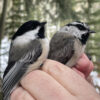Despite being a renewable energy source, the use of biofuel is controversial, as growing few, highly productive crops for fuel can lead to biodiversity loss in the cropping systems where biomass is produced. A cropping system refers to the crops, their sequence, and the management practices on a given field.
Now, researchers in the US have compared ant communities in different types of bioenergy cropping systems to better understand how these systems shape biotic communities and their functions. The results are published in Frontiers in Conservation Science.
“We found different ant communities when we compared annual crops, perennial systems, and diverse perennial polycultures with many plant species,” said first author Dr. Nathan Haan, who collected data for this study at Michigan State University’s Kellogg Biological Station and currently researches the ecology of insects as an assistant professor at the University of Kentucky.
“Perennial bioenergy cropping systems, particularly those that incorporate more plant diversity, give rise to a different and more diverse ant community than simpler systems.”
Ants and crops
Ants are abundant and influential players in grasslands and agroecosystems. They can be important predators, seed dispersers, and soil engineers. “If large parts of our landscapes become dedicated to growing crops for fuel, ants are a top candidate to investigate how insect communities could differ from crop to crop,” Haan explained.
The researchers examined 10 bioenergy cropping systems in an experimental array in Michigan. The systems included annual crops (corn and two types of broomcorn), simple perennial (multi-year) systems (two switchgrasses, miscanthus, and a native grass mix), and diverse perennial systems (reconstructed prairie, successional volunteer vegetation, and a short-rotation coppicing system with poplar trees).
The researchers captured almost 10,000 individual ants belonging to 22 species. In complex ecosystems, ants carried out more functional roles—for example, predator or seed disperser—than in simple systems. Species richness was highest in diverse and lowest in simple systems. Community composition also differed: Some common ant species were found in all cropping systems; rarer species, however, only showed up in plant-diverse perennial systems.
Optimizing crops for fuel
The tested crops have different pros and cons for biofuel production, the researchers pointed out. Some of them are more productive, but have little conservation value; others, while less productive, have conservation benefits. For example, perennials can help store carbon belowground in their roots. Mixed-species prairies can also be very productive and are much more biodiverse, however, there are more unknowns about how to use their biomass to generate end products.
“It’s a matter of understanding trade-offs and figuring out how to optimize them,” Haan pointed out. Currently, 40% of the corn produced in the US is used to make ethanol, which is often used as fuel. Growing this much corn in monocultures, however, is an inherently unsustainable solution to fuel the future.
“There are a range of other cropping systems that could be adopted and become mainstays. We need to understand which of these are biodiversity-friendly and which are not,” Haan said.
Biofuel production groundwork
The researchers hope their study will inform decisions about which crops can be used for sustainable biofuel production, where those crops are grown, and how they are managed.
“Bioenergy seems to go in and out of fashion in the news and public discourse, but projections are that we will need to deploy bioenergy crops at large scales in coming decades in order to successfully combat climate change,” Haan said.
Although the present research was carried out in a single experimental array, the general patterns are expected to be similar in other places, Haan said. It is, however, necessary to gather more specific information in other contexts.
More information:
Bioenergy cropping systems shape ant community composition and functional roles, Frontiers in Conservation Science (2024). DOI: 10.3389/fcosc.2023.1283225
Citation:
Ants help reveal why sourcing different plants for eco fuels is crucial for biodiversity (2024, January 23)



